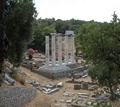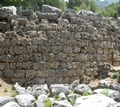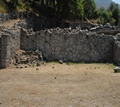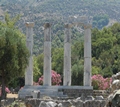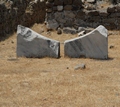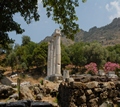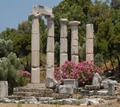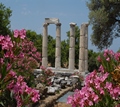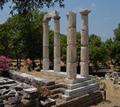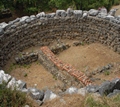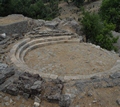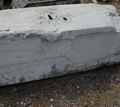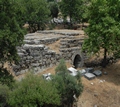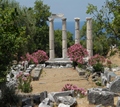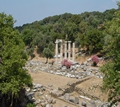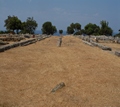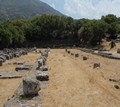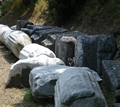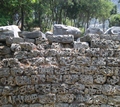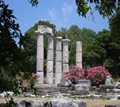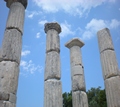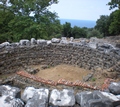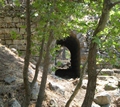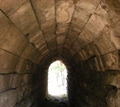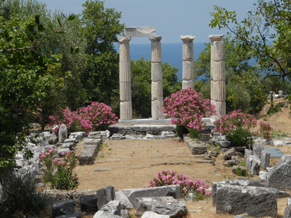
The Sanctuary of the Great Gods or Samothracian Gods or Kaveri, was the most important religious center of the island during antiquity. It was not the official sanctuary of the city but a sanctuary of "international" scope, like those of Olympia and Delphi. It has functioned as a sacred place since ancient times, as it is associated with the pre-Hellenic, Thracian inhabitants of Samothrace. But, later, the Greeks adopted this worship and gave it a new breath and dimension. In the sanctuary of the Great Gods, the Great Mother was worshipped, the female deity of nature, (corresponding to the Phrygian Cybele) who in the local idiom was called "Axieros" and identified with Demeter. She was represented seated, between lions, holding a scepter and a flask.
Father of the Great Goddess and her husband was an ithyphallic god of fertility that the locals called Kadmilo or Kasmilo who was identified with Hermes. His symbols were the ram and the caduceus. Followers of the holy couple were two young ithyphallic "demons" called Kaveri, whom the Greeks identified with the Dioscuri. Others argue that the Kaveri should be identified with the brothers Dardanus and Iasion/Hetion who were also considered the founders of the Kaverian Mysteries. To these four pre-Greek deities was added, probably by the Greeks, the chthonic divine couple of Axiokers and Axiokers, who are identified with the rulers of the Underworld, Hades and Persephone. The earliest signs of worship in the Sanctuary of the Great Gods go back to the 7th century BC, while the building remains date from the beginning of the 4th century BC until the 1st century A.D.
The most important relics are the watercolors of Kenan Mesare, son of the Turkish general Hasan Taksin Pasha. They depict the then prime minister Eleftherios Venizelos, Evzonas keeping watch outside the inn, the Greek soldier in Epirus, the women of Epirus carrying ammunition for the Greek Army, as well as the civilians and the wounded. Finally, Esat Pasha and the Turkish commander of the Ioannina are depicted conversing with the Commander-in-Chief Constantine after the surrender of the Ioannina.
Coming from the path of the Museum, the visitor can see: 1) the Palace with the "Holy House" (1st century AD) where it has been argued that the ceremonies of the first degree of the mysteries, the "initiation ». 2) the Arsinoeion, an impressive circular two-story building, a dedication of the Ptolemaic queen Arsinoe, in the form of a dome (288 - 281 BC), which was used for the official gatherings of the faithful. 3) the Sacred Rock, a porphyry stone, where sacrifices were offered to the gods. 4) the cave of Hecate Zirinthia. 5) the Temple or building with the Dancers in the center of the Sanctuary, a large marble building with an elegant Ionic propylon dedicated by the Macedonian king Philip II (340 BC) where the initiation took place. 6) the Hieron, which was a Doric style temple with an arched shelter. Next to it are the Hall of Votives, the courtyard of the Great Altar and the Theatre. On the western hill stand out a large Stoa (first half of the 3rd century BC), for the accommodation of the numerous visitors, and the Fountain, where the statue of Victory was erected on the prow of a ship (beginning of the 2nd century BC ., today at the Louvre).
Crossing the eastern ravine, one reaches the Propyla of Ptolemy II (285 - 280 BC), an amphiprostyle building with Ionic and Corinthian columns. Directly opposite, on the eastern hill, there is a circular space with a diameter of 9 m. dating to the beginning of the 4th century. BC, with tiers where spectators stood and watched the performance of sacred acts. The preliminary initiation was probably held in this place. Right next to it there is a Doric style marble building, a dedication of Philip III Arridaios and Alexander IV (323 - 316 BC). The Sanctuary of the Great Gods is located at a distance of 6 km from Kamariotissa.
Editor: Fotini Anastasopoulou










